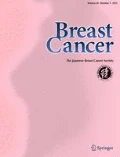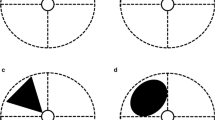Abstract
Background
A preoperative diagnosis of ductal carcinoma in situ (DCIS) is sometimes upstaged to invasive disease postoperatively. Our objective was to clarify the predictive factors of invasive disease using preoperative imaging and to investigate the positive ratio of sentinel lymph nodes (SLN) and the incidence of invasive disease.
Methods
The subjects were 402 patients with preoperatively diagnosed ductal carcinoma without stromal invasion who underwent breast surgery with concomitant SLN surgery in January 2007 to December 2016. Of the 306 included patients, all 306 patients underwent preoperative MRI and US assessment. Outcomes were analyzed for significance using univariate and multivariate analyses.
Results
Of the 306 patients, 115 (37.6%) had invasive disease and 191 (62.4%) had DCIS only. Of the 115 patients with invasive disease, 5 (4.4%) and 4 (3.5%) had macro- and micrometastases in SLN. On the other hand, of the 191 patients with DCIS, only 1 (0.5%) had a micrometastasis. Predictors of invasive disease in the univariate analysis included having a palpable mass, were varied by biopsy method, having a US hypoechoic mass, MRI enhancement, or MRI large enhanced lesion; the size of the mass enhancement ≥ 1.1 cm or a spread of non-mass enhancement ≥ 3.1 cm (P = 0.003). Predictors of invasive disease in the multivariate analysis included US hypoechoic mass and MRI large enhanced lesion.
Conclusion
We need to perform SLN biopsy for preoperatively diagnosed DCIS when patients have predictors of invasive disease, but SLN biopsy will no longer be essential for patients when they have no predictors of invasive disease.

Similar content being viewed by others
References
Brinton LA, Sherman ME, Carreon JD, Anderson WF. Recent trends in breast cancer among younger women in the United States. J Natl Cancer Inst. 2008;100(22):1643–8.
Virnig BA, Tuttle TM, Shamliyan T, Kane RL. Ductal carcinoma in situ of the breast: a systematic review of incidence, treatment, and outcomes. J Natl Cancer Inst. 2010;102(3):170–8.
Cox CE, Nguyen K, Gray RJ, Salud C, Ku NN, Dupont E, et al. Importance of lymphatic mapping in ductal carcinoma in situ (DCIS): why map DCIS? Am Surg. 2001;67(6):513–9.
Yen TW, Hunt KK, Ross MI, et al. Predictors of invasive breast cancer in patients with an initial diagnosis of ductal carcinoma in situ a guide to selective use of sentinel lymph node biopsy in management of ductal carcinoma in situ. J Am Coll Surg. 2005;200(4):516–26.
Mittendorf EA, Arciero CA, Gutchell V, Hooke J, Shriver CD. Core biopsy diagnosis of ductal carcinoma in situ:an indication for sentinel lymph node biopsy. Curr Surg. 2005;62(2):253–7.
Goyal A, Douglasones A, Monypenny I, et al. Is there a role of sentinel lymph node biopsy in ductal carcinoma in situ? Breast Cancer Res Treat. 2006;98(3):311–4.
Moran CJ, Kell MR, Flanagan FL, Kennedy M, Gorey TF, Kerin MJ. Role of sentinel lymph node biopsy in high—risk ductal carcinoma in situ patients. Am J Surg. 2007;194(2):172–5.
Tan JC, McCready DR, Easson AM, Leong WL. Role of sentinel lymph node biopsy in ductal carcinoma—in—situ treated by mastectomy. Ann Surg Oncol. 2007;14(2):638–45.
Cserni G, Bianchi S, Vezzosi V, Arisio R, Bori R, Peterse JL, et al. Sentinel lymph node biopsy in staging smallbreast carcinomas. Pathol Oncol Res. 2007;13:1–2.
Pendas S, Dauway E, Giuliano R, et al. Sentinel node biopsy in ductal carcinoma in situ patients. Ann Surg Oncol. 2000;7:15–20.
Klauber-DeMore N, Tan LK, Liberman L, et al. Sentinel lymph node biopsy: is it indicated in patients with high-risk ductal carcinoma-in-situ and ductal carcinoma-in-situ with microinvasion? Ann Surg Oncol. 2000;7:636–42.
Cox CE, Nguyen K, Gray RJ, et al. Importance of lymphatic mapping in ductal carcinoma in situ (DCIS): why map DCIS? Am Surg. 2001;67:513–9.
Intra M, Veronesi P, Mazzarol G, et al. Axillary sentinel lymph node biopsy in patients with pure ductal carcinoma in situ of the breast. Arch Surg. 2003;138:309–13.
Brinkmann E, Rademaker A, Morrow M. Is sentinel lymph node biopsy (SLNB) for ductal carcinoma in situ (DCIS) justified [abstract]? Ann Surg Oncol. 2002;9:S57.
van Roozendaal LM, Goorts B, Klinkert M, Keymeulen K, De Vries B, Strobbe LJA, et al. Sentinel lymph node biopsy can be omitted in DCIS patients treated with breast conserving therapy. Breast Cancer Res Treat. 2016;156(3):517–25.
De Gournay E, Guyomard A, Coutant C, Boulet S, Aveux P, Causeret S, et al. Impact of sentinel node biopsy on long-term quality of life in breast cancer patients. Br J Cancer. 2013;109:2783–91.
Purushotham AD, Upponi S, Klevesath MB, Bobrow L, Millar K, Myles JP, et al. Morbidity after sentinel lymph node biopsy in primary breast cancer: results from a randomized controlled trial. J Clin Oncol. 2005;23(19):4312–21.
Del Bianco P, Zavagno G, Burelli P, Scalco G, Barutta L, Carraro P, et al. Morbidity comparison of sentinel lymph node biopsy versus conventional axillary lymph node dissection for breast cancer patients: results of the sen- tinella-GIVOM Italian randomised clinical trial. Eur J Surg Oncol. 2008;34(5):508–13.
Mansel RE, Fallowfield L, Kissin M, Goyal A, Newcombe RG, Dixon JM, et al. Randomized multicenter trial of sentinel node biopsy versus standard axillary treatment in operable breast cancer: the ALMANAC Trial. J Natl Cancer Inst. 2006;98(9):599–609.
Langer I, Guller U, Berclaz G, Koechli OR, Schaer G, Fehr MK, et al. Morbidityof sentinel lymph node biopsy (SLN) alone versus SLN and completion axillary lymph node dissection after breast cancer surgery: a prospective Swiss multicenter study on 659 patients. Ann Surg. 2007;245(3):452–61.
Wilke LG, McCall LM, Posther KE, Whitworth PW, Reintgen DS, Leitch AM, et al. Surgical complications associated with sentinel lymph node biopsy: results from a prospective international cooperative group trial. Ann Surg Oncol. 2006;13:491–500.
Schneider C, Trocha S, McKinley B, Shaw J, Bielby S, Blackhurst D, et al. The use of sentinel lymph node biopsy in ductal carcinoma in situ. Am Surg. 2010;76(9):943–6.
Miyake T, Shimazu K, Ohashi H, Taguchi T, Ueda S, Nakayama T, et al. Indication for sentinel lymph node biopsy for breast cancer when core biopsy shows ductal carcinoma in situ. Am J Surg. 2011;202(1):59–65.
Ozkan Gurdal S, Cabioglu N, Ozcinar B, Muslumanoglu M, Ozmen V, Kecer M, et al. Factors predicting microinvasion in Ductal Carcinoma. Asian Pac J Cancer Prev. 2014;15(1):55–60.
Prendeville S, Ryan C, Feeley L, Connell F, Browne TJ, Sullivan MJ, et al. Sentinel lymph node biopsy is not warranted following a core needle biopsy diagnosis of ductal carcinoma in situ (DCIS) of the breast. The Breast. 2015;24:197–200.
Brennan ME, Turner RM, Ciatto S, et al. Ductal carcinoma in situ at core- needle biopsy: meta-analysis of underestimation and predictors of invasive breast cancer. Radiology. 2011;260:119–28.
Osako T, Iwase T, Ushijima M, Horii R, Fukami Y, Kimura K, et al. Incidence and prediction of invasive disease and nodal metastasis in preoperatively diagnosed ductal carcinoma in situ. Cancer Sci. 2014;105(5):576–82.
Jakub JW, Murphy BL, Gonzalez AB, Conners AL, Henrichsen TL, Maimone S, et al. A validated nomogram to predict upstaging of Ductal Carcinoma in Situ to invasive disease. Ann Surg Oncol. 2017;24(10):2915–24.
Kondo T, Hayashi N, Ohde S, Suzuki K, Yoshida A, Yagata H, et al. A model to predict upstaging to invasive carcinoma in patients preoperatively diagnosed with ductal carcinoma in situ of the breast. J Surg Oncol. 2015;112(5):476–80.
Sagara Y, Mallory MA, Wong S, Aydogan F, DeSantis S, Barry WT, et al. Survival benefit of breast surgery for low-grade Ductal Carcinoma In Situ: a population-based cohort study. JAMA Surg. 2015;150(8):739–45.
Author information
Authors and Affiliations
Corresponding author
Additional information
Publisher's Note
Springer Nature remains neutral with regard to jurisdictional claims in published maps and institutional affiliations.
About this article
Cite this article
Maeda, H., Hayashida, T., Watanuki, R. et al. Predictors of invasive disease in patients preoperatively diagnosed with ductal carcinoma without stromal invasion, with breast magnetic resonance imaging (MRI) and ultrasound (US). Breast Cancer 28, 398–404 (2021). https://doi.org/10.1007/s12282-020-01187-9
Received:
Accepted:
Published:
Issue Date:
DOI: https://doi.org/10.1007/s12282-020-01187-9




